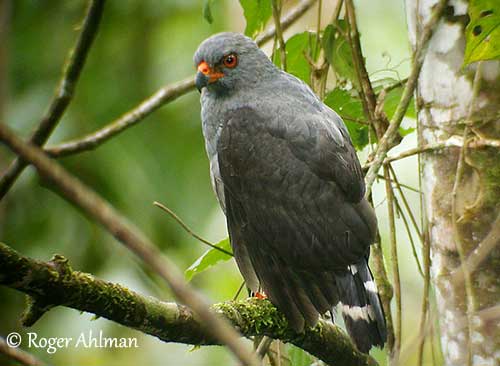
The breeding behaviour of this species is unknown. This raptor is usually seen solitary or in pairs.
Male and female may performs duets.
The Plumbeous Hawk is probably sedentary.
It generally flies low through the forest. It rarely or never soars. The active flight is direct, with rapid wingbeats.
REPRODUCTION OF THIS SPECIES:
The breeding habits of the Plumbeous Hawk are unknown.
It was formerly a member of the genus Leucopternis. These raptors usually build stick nests in the crown of tall trees.
Raptors are often territorial and defend their home range and especially the nest-site where the territorial defence is high during the nesting cycle.
They are usually monogamous, often with long term pair-bonds.
PROTECTION / THREATS / STATUS:
The Plumbeous Hawk has been affected by intensive deforestation, involving destruction of the habitat across most of the range.
Deforestation is mainly driven by agriculture expansion, but also by logging and mining activities. However, some parts of the habitat are now within protected areas.
This species is described as uncommon. The population is roughly estimated to number 10,000 mature individuals. It is declining rapidly due to habitat destruction.
The Plumbeous Hawk is often inconspicuous and may be under-recorded within its range. It is currently listed as Vulnerable.
Fr: Buse plombée
Ang: Plumbeous Hawk
All: Bleibussard
Esp: Busardo Plomizo
Ita: Poiana piombata
Nd: Donkergrijze Buizerd
Sd: blygrå vråk
Photographer:
Roger Ahlman
Pbase Galleries Peru and Ecuador
Text by Nicole Bouglouan
Sources:
HANDBOOK OF THE BIRDS OF THE WORLD Vol 2 by Josep del Hoyo-Andrew Elliot-Jordi Sargatal - Lynx Edicions - ISBN: 8487334156
Birds Of Central America: BELIZE, GUATEMALA, HONDURAS, EL SALVADOR, NICARAGUA - De Andrew C. Vallely, Dale Dyer – Editeur: Princeton University Press, 2018 – ISBN: 0691138028, 9780691138022 - 584 pages
The Illustrated Encyclopedia of Birds De DK, BirdLife International – Editeur: Dorling Kindersley Ltd, 2011 – ISBN: 1405336161, 9781405336161 - 512 pages
A GUIDE TO THE BIRDS OF COLOMBIA by Steven L. Hilty and William L. Brown - Princeton University Press – ISBN 069108372X
Birds of Ecuador De Robin Restall, Juan Freile – Editeur: Bloomsbury Publishing, 2019 – ISBN: 147297249X, 9781472972491 - 576 pages
Raptors of Mexico and Central America De William S. Clark, N. John Schmitt – Editeur: Princeton University Press, 2017 – ISBN: 1400885078, 9781400885077 - 272 pages
RAPTORS OF THE WORLD by James Ferguson-Lees et David Christie - Helm Identification Guides – ISBN: 0713680261
Avibase (Denis Lepage)
Global Raptor Information Network - Working to Conserve Birds of Prey in nature
Plumbeous Hawk
Cryptoleucopteryx plumbea
Accipitriformes Order – Accipitridae Family
INTRODUCTION:
The Plumbeous Hawk is a rare raptor found in Panama, Colombia and Ecuador to extreme NW Peru. This species is very poorly known.
It frequents humid and wet forests in lowlands and foothills, up to 800 metres of elevation. It feeds on small vertebrates, mainly aquatic prey such as amphibians, crabs, fish and water snakes, by hunting along lake shores and river banks. The breeding behaviour is unknown.
The Plumbeous Hawk is threatened by degradation and destruction of its habitat caused by intense deforestation for agriculture expansion. The species is currently listed as Vulnerable.
DESCRIPTION OF THE BIRD:
Biometrics:
Length: M: 32 cm – F: 35 cm
Wingspan: 71-79 cm
Weight: 500 g
The Plumbeous Hawk is a fairly small, bulky raptor with short, broad, rounded wings.
The adult has plain, slate-grey plumage overall, but the tail is blackish with only one white band. The upperwing is dark grey to blackish. Head, mantle, upper back and underparts are pale grey. The underwing is white with blackish tips of primaries and trailing edge. Thighs are finely streaked grey and white. Chin and throat are darker grey.
The bill is blackish with orange cere. The eyes are red. Legs and feet are red-orange, with black talons.
Male and female have similar plumage, but the female is slightly larger than male.

The juvenile resembles adult but it shows white barring on belly, flanks and thighs. The uppertail-coverts are tipped white. There is sometimes a second, narrower, white band on the tail. The eyes are browner.
RANGE:
The Plumbeous Hawk is found from E Panama through W Colombia and NW Ecuador to extreme NW Peru.
HABITAT:
The Plumbeous Hawk frequents humid and wet forest, often in foothills, but also locally in lowlands. It is usually seen along paths and in clearings, and especially on lake shores and river banks. It has been recorded in degraded forests too. The species is visible between 200 and 800 metres of elevation.
CALLS AND SONGS: SOUNDS BY XENO-CANTO
The Plumbeous Hawk gives a loud, whistled, mournful “weeeééaa…weeééaa…wëëa-wëëa…” and a high, thin “wheee-urr”. A quavering, woodpecker-like call can be heard when the bird is excited “wh-i-i-i, wh-i-i-i,whi-i-i-i”
BEHAVIOUR IN THE WILD:
The Plumbeous Hawk feeds on various vertebrates such as frogs, crabs, fish and water snakes, but it probably takes small mammals and large insects too.
This raptor hunts along lake shores and river banks, probably from perches and sitting for long periods, mainly sit-and-wait hunting method.
It may occasionally perch on exposed snags above the forest from which it vocalizes, usually in the early morning. But it is more often perched in shaded forest interior.
